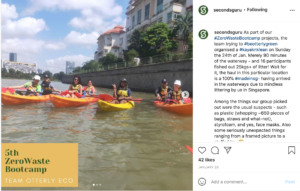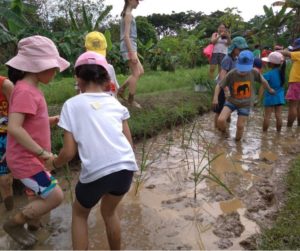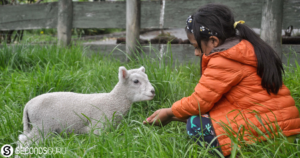Published 27 April 2021 ● Last Updated on 18 May 2021
- Is your child more comfortable maneuvering the complexities of a video game than the steps to climb a tree?
- Do screens take up most of his/her playtime?
- Do you wish your kid’s childhood was more like yours- with ample open space to play for hours at end?
Well you are not alone! Faced with the same challenges, I struggle to ply my 9-year-old son away from his digitally induced slumber to ensure that he spends some time outdoors in nature.
But hey… What’s the big deal?
As it turns out, growing detachment for the natural world has many unpleasant side effects aptly named ‘nature deficit disorder’, a term coined by author Richard Louv in his book Last Child in the Woods: Saving our Children from Nature-Deficit Disorder. Resulting from a lack of imaginative play time and exploratory outdoor activities, this is a condition characterized by a lack of attention, rise in obesity and other learning and behavior disorders. This disassociation seems to be rather alarming amongst teenagers as they emerged as the largest age group with a disconnect with nature in a study. As a nature-lover myself, it is important to me that my son grows up to not only appreciate nature, but to learn to do what he can to help protect our natural environment. Here are a few simple ways to build connection with nature (few of them tried and tested) amongst children and young adults:
1. Don’t wait for the perfect time. Create small opportunities
Connecting kids and nature is fairly simple. No need to venture into a deep jungle. There are plenty of opportunities available in and around our homes as fun ways to get kids outside in nature. Instead of waiting to make a trip to the perfect destination, take children to the park nearby where they can go around looking for small rocks and pebbles in special shapes and colours. Take them on a leisurely stroll around the neighbourhood to notice small things like a butterfly on a branch. For his daily dose of nature I have given my son the ownership of a small plant at home and made him responsible for its care.
As a way to get teenagers to engage with nature, have them walk/bike from school or to nearby places as they run errands. This is a simple way to ensure they get in some exercise and fresh air on a daily basis as well as an opportunity to observe the passing world. Older kids will love the freedom of a night-time walk which can help them see the outdoors in a very different light- with added thrill of using cool gadgets like headlamps. Every small exposure to nature-trees, plants, animals, insects or water, regardless of the size, can deliver considerable benefits to you and your children.

2. Give them a goal
How do you bring back nature into kids’ lives, especially when the lure of mind-numbing screen daze is higher? Activities which require close observation and include the achievement of a goal can help you with that. Put up a bird feeder and encourage them to observe and list the number of birds which visit it every day. This will spur them to look out for more birds and is a fun way to get kids take notice of their surroundings . At my mother’s house in Kanpur (India), we took special pleasure in watching squirrels scamper around the bird feeder and disappear into the folds of the metal roof – our goal was to be able to tell the squirrels apart after a few days of close observation. Another way to get a teenager starved of nature time outdoors is to get him/her involved in park/beach/school yard cleanups – it gives them a sense of purpose and motivates them to be outdoors.

3. Don’t say no. Let them take risks.
“No, don’t jump into that puddle” or “No, don’t pick up that stick”. If you want your kids to develop a connection with nature – you need to allow them to interact with it. This means not saying ‘no’ and giving them a free hand while engaging in low-risk outdoor play. Let dirt be fun for kids. Don’t stop them from kicking a pile of dry leaves. Let them learn how to navigate risk and take calculated decisions with independent activities such as climbing trees or throwing pebbles in the water. Allowing nature to become a part of their imaginary world – where they execute full control, can help kids build a connection with nature.

4. Make them fall in love with the outdoors. Create and share experiences
If you are looking for ways to connect kids with nature, give them a chance to be captivated by it. With no dearth of nature trails in Singapore to choose from, you can share amazing experiences with them over walks and hiking. Dial up the fun quotient for older kids by adding the challenge of using a map or a compass. On holidays ensure to take time out of shopping and sightseeing to plan immersive natural activities.
I saw this first-hand on a holiday in the outskirts of Mumbai (India). Trekking up to the Karnal Fort, my son was enthralled by the pathway created by rocks and roots. This first-hand experience with nature’s handiwork filled with him a sense of wonderment and awe which no youtuber ever could! During another holiday, strawberry picking was the highlight of our trip. Road trips too make for great family adventure and the perfect opportunity to embrace nature along the way.
A lecture on benefits of connecting with nature is likely to fall on the deaf ears of a reluctant teenager, but the idea of ‘coolness’ isn’t. Old enough for some physically demanding activities, encourage teenagers to pick activities with an adrenaline rush or a sporty element. Something like kayaking, rollerblading, ziplining or simply cycling – which take them outdoors. Restore balance in their crazy study schedule with forest bathing– an activity which gives them a chance to practice mindfulness and focus on their senses. Sensitizing your kids to nature is one of the best gifts you can give. You just have to figure out the fun quotient.

5. Interaction with animals
Have you seen a kid whose eyes don’t light up with delight when a colourful butterfly flits past them? I am yet to come across one. Even the most shy kid will gladly open up if asked about their favourite animals. Nurture the natural inclination children have – this not only deepens their appreciation for nature but also helps develop sensitivity to others and hone social skills. Allow them to take responsibility for tasks in taking care of their own pet or letting them play with their friend’s pet. Make plans to go on a wildlife safari (don’t forget to look up the signs of an unethical safari while you are at it) for an immersive animal experience. Make do with virtual tours while you wait for the borders to open! You can also play animal-related games : if stuck indoors, look up quizzes on Kahoot! and board games that feature animals. Nothing like outdoors of course: standing by dog parks, volunteering at animal shelters, searching for animal tracks in mud or sand, binocular-gazing for nests – all provide an opportunity to build a connection with our fellow planet citizens!

6. Make technology your friend
Inundated with studies and extra-curricular activities, kids withdraw from nature as they grow older – an age research pegs at 11. With growth in depression amongst teenagers, older kids need the benefits of nature more than ever as they go through a period of confusing developmental changes. Since this is a generation which cannot put their smartphones down, make technology a tool of engagement with nature. Leverage their addiction to gadgets to reintroduce your teen to nature. A fun way to do this to introduce your teen to nature photography on their smartphones. Encourage them to share pics on social media or participate in online competitions- a perfect blend of screen time and time with nature.
Parting thoughts
Regardless of your approach, it is important to make your kids spend time outdoors so they can gain from the benefits of connecting with nature. Not only will this equip them to be stewards for Planet Earth, but also help with confidence building, improvement in mental and physical health and preparation for success in ways in which formal setting cannot prepare them. However, as you make conscious efforts to schedule nature time, be vary of making it seem like a punishment for too much screen time. That’s likely to put them off nature completely.
Related links:



0 Comments